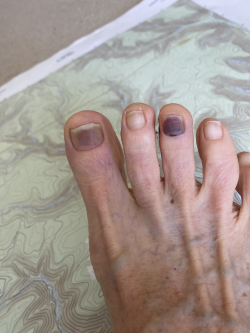Blue-Line Fly-Fishing, My First Adventure
Blue-line fly-fishing and my first adventure came about when I suddenly realized there was a word and a concept for how I spent my childhood. No one in my family fished or hung-out in the outdoors. But on my own, I played in small streams the way other kids catch baseball, play games in the street or build with Legos. I was drawn to the outdoors by some inexplicable force.
The tiny stream wound through greenbrier, viburnum, and rhododendron. Its thin, sparkling flow spread wide and shallow until it met a sandstone-and-shale shelf. There, a miniature falls dropped into a bathtub-sized pool. A muscular sycamore leaned over the water, casting cool shade across the surface. And through the shifting ripples, I could see—fish.
After retirement, I began fly fishing in earnest—not only to practice the craft and catch fish, but to reflect and explore the landscape of my past: how, despite a turbulent childhood steeped in angst and pressure to conform, I discovered my true calling as a wildlife biologist.
A Primal Connection
I feel instinctively pulled toward small streams. They are my conduit, a ritual of return to the child within. The mood, sounds, smells, vibrations—the ripples connect me to a time when I was an open book, more curious and less learned. It was a time when a fishing rod was too complex, when fishing meant chasing water striders, turning over rocks, and catching chubs, salamanders, and crayfish in a bucket.
Roadside and drift-boat fly fishing helped me find a piece of the invisible force that kept me on a seemingly predetermined course. But when I read about blue-line fly fishing, the connection hit me like a flash of lightning—sudden, electric, undeniable.
Blue-lining means following the thin blue lines on a topo map: little-known, almost secret stretches of fish habitat that remain wild and untamed. You may sometimes see boot tracks, mudder tire tracks, even a camp. But if you trek far enough, you leave pavement and civilization behind. That is the point where fly-fishing transforms into discovery—communion with the best of what Nature offers: feral trout and wildlands.
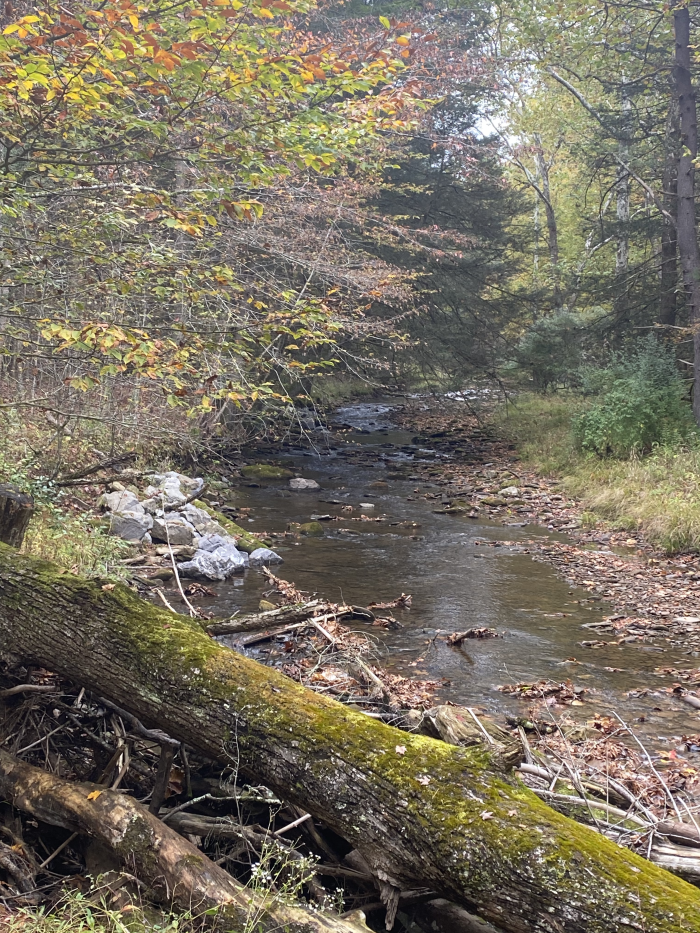
For weeks I pored over USGS quadrangle maps, tempering courage and excitement to match my experience. This would be new territory, well outside my comfort zone. I studied contour lines, trail distances, and water access, because this exploration would give me an honest assessment of how I was aging.
I have taken strength tests, aerobic tests, and mobility tests. I even maxed out my doctor-prescribed treadmill stress test. But tests performed in the gym or any static setting deliver in-kind results—dry and flat. How you perform in the field is the real measure, the real target of all your efforts. How you endure, feel, and enjoy your experience in real time and afterward is key. Like with most efforts, action and execution will reveal areas that may need attention going forward.
Nature’s hazards have a way of finding your weak points. That is the crux of the outdoor life—of fly-fishing and aging. Crisis finds you as you are, not as you wish you were.
After securing a base camp with the revered Kettle Creek Lodge folks and inviting a few buddies, I set aside clothing for frosty mornings and warm, sunny afternoons. Most important was my choice of waders. With plans to hike four to six hours a day, I needed waders that were light and pliable while tough enough to push through thick greenbrier and rhododendron. Simms Freestone waders fit the bill. Their lightweight material helps you forget you’re wearing them, and they protect a large portion of your body from the most likely personal threat you’ll encounter: deer ticks. A deer tick bite can spread Lyme disease, babesiosis, and anaplasmosis. Prevention is the best course of action, but if you find a tick or evidence of a bite, see a doctor. Too many fly fishers suffer from the long-term effects of Lyme.
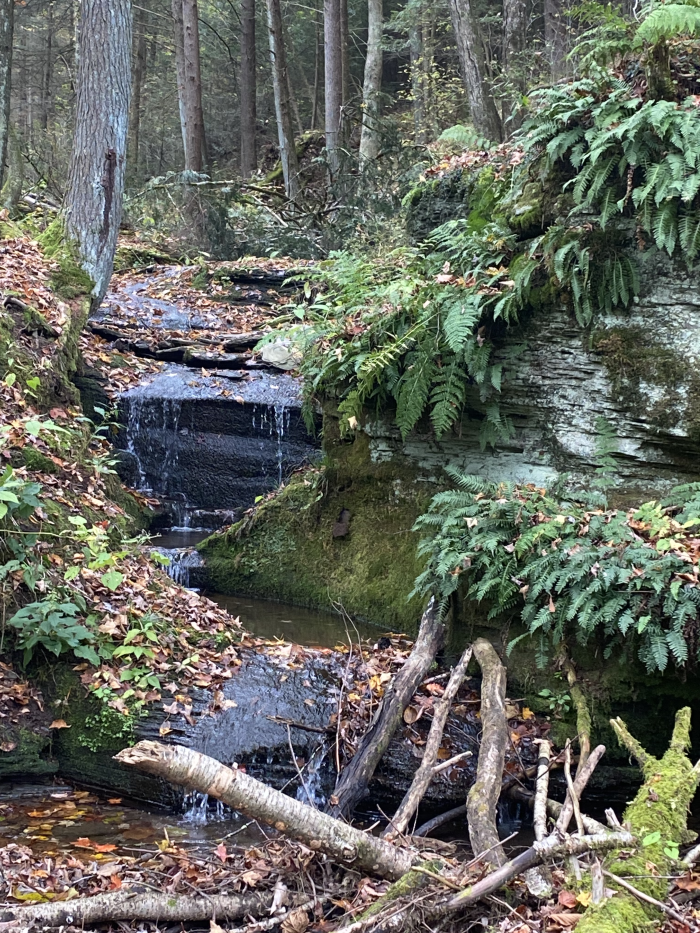
The size of a fly rod is an individual choice, but I have found a two-or three-weight rod with matching line ideal. For single-day pack-in outings, you need minimal food and drink. A fanny pack and a multi-pocket vest (I like Patagonia’s) are light and simple enough to let you go deep into the backcountry.
Wilderness
For many, blue-lining evokes the West—vast roadless lands with streams in designated Wilderness Areas. But you don’t need to travel for days to immerse yourself in the wild. There is Wilderness, and then there is wilderness character. You can find the latter in any small stream or forest near home.
The Largest Roadless Area in Pennsylvania
This three-day adventure was in the state-designated Hammersley Wild Area, a 30,253-acre roadless tract in the Susquehannock State Forest in Potter and Clinton Counties in north-central Pennsylvania. Here, a map and compass are essential; a cell phone is useful only as a camera.
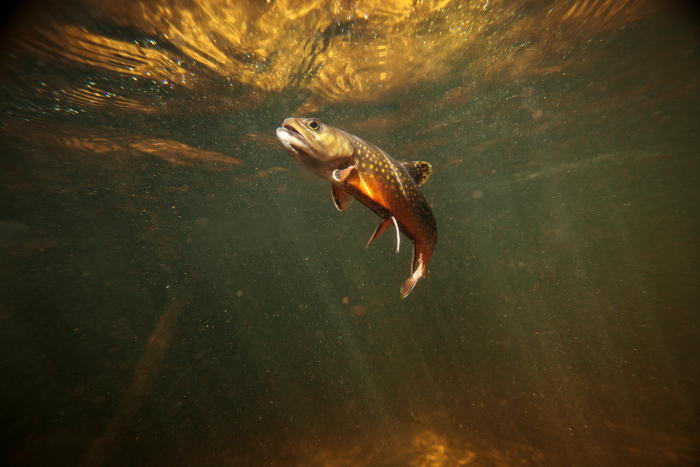
We hiked and fished for brook trout in the Class A designated Nelson Branch, a tributary of the more accessible Kettle Creek. The Pennsylvania Fish and Boat Commission describes Class A water as “streams that support a population of naturally produced trout of sufficient size and abundance to support a long-term and rewarding sport fishery.” I understand the importance of trout biomass, but I also caught a glimpse of the ecosystem that sustains this thriving trout population. I flushed wood ducks and American woodcock. And I heard the drumming of ruffed grouse, a keystone species.

Wood Turtle

Fishing spiders in the genus Dolomedes found in and around streams hunt for small fish and other prey.
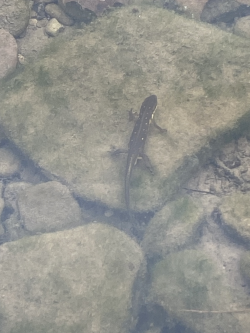
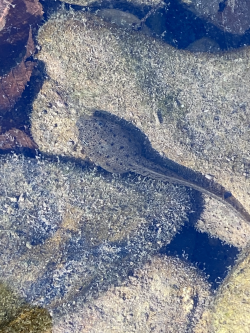
Blue-Line Fly-Fishing, The Road to Heaven
Blue-line fly-fishing offers an intensely quiet and still connection worth training for. The solitude is so complete you sometimes pinch yourself because it feels otherworldly.
Catching fish can be challenging, and on the surface, may appear unrewarding. But what is ironclad is the promise of stillness—serenaded by ripples, water-loving, insect-eating warblers, or the soft flutter of a song sparrow’s wingbeat. Absolute reality.
On this October excursion, I did not count miles. Doing so would have taken away from the labyrinth experience—the physical and mental meandering that soothes the psyche.
This Freedom Is Not Free
Communing with the wilds is fly-fisher sustenance with added degrees of peak-level repose. But the cost of admission is an uncommon level of fitness. Very few people make the connection between the perceived drudgery of exercise—building strength, stamina, and endurance—and the rewards of nirvana.
Early fall in Pennsylvania is usually dry, and this year was no exception. Everyone knows what low; clear water does to trout behavior. We sat, crawled, and kneeled more than we stood. Not only were the brook trout spooked, but they were spawning. Practically prone, we cast our best flies to spawning sites—no tight lines.
Brook trout spawning at the Nelson Branch tributary of Kettle Creek.
On the last day, we left the roadless area for a few hours to reacquaint ourselves with the tug, the pull, the life at the end of a two-weight rod. We found fall trout in Kettle Creek.
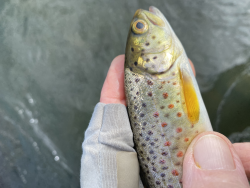
All fish are kept wet & released unharmed
Extreme Sports
Extreme sports are described as activities involving a high degree of physical exertion, specialized gear, risk, and technical skill, usually in demanding environments. Blue-lining meets that criteria. Perhaps this is a nudge to adopt blue-lining as an approach to life. Life itself involves physical demands, exertion, technical skill, risk—and death.
Everyone will eventually feel the weight of years, the drag of age on physicality. Shouldn’t we proactively increase our efforts to stay in the blue-lining game?
The best gear and flies will give you confidence. But a rock-solid foundation of strength, stamina, and endurance is the apex of confidence. It’s wealth beyond equipment. It gives you freedom to go anywhere, in all conditions. With the extremes muted, you can fully immerse yourself in the experience—fly fishing with complete focus on blue-line water and its fish.
Afterward
The only recovery needed was clean-up. Aches, pains, and stiffness were minimal to non-existent. The prevailing attitude now: I’m already planning a spring blue-line adventure, when there will be more water and the brookies aren’t spawning. I’ll also be looking for new wading boots; experience exposed a weak spot. The Simms Freestone boots run a bit narrow.
Blue-Line Fly-Fishing, Not Everything That Counts Can be Counted
If you make building the physical ability to blue-line fly fish regularly your priority, you’ll bathe in an ambience of stillness that will begin to nurture an internal stillness. Perhaps that’s the ultimate freedom —personal sovereignty. You know where you’re going and how to get there. You have purpose–too busy improving yourself to spin your wheels on what maas culture thinks or the opinions of others.
Years have given you wisdom—aging requires a change in posture—mental as much as physical. The rewards of your new purpose are not a flashy headline. Real life is quiet and unremarkable. Blue-lining is the perfect metaphor because it too happens in the margins, the small, quite moments that don’t trend or go viral.
Articles (like this one) on blue-lining are pointers, truth second hand. The experience and feel of it brings life to what cannot be put into words.
Want to learn more? Interested in joining a community of like-minded fly fishers, outdoor types–anyone interested in making strength and longevity a daily practice? If you would like to discuss your ideas, what has worked or not worked for you, examine what might help you, have conversations and get feedback on how you live the strenuous life now, or post retirement, join us on Substack.
This is for anyone who wants to engage and discuss how to stay fit for more blue-lining!
Learn more and …..join our community on Substack!
Categorized in: General Knowledge

